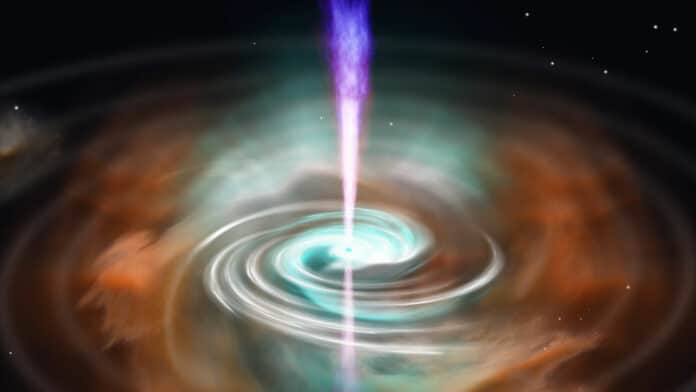According to scientists, the engine that powers energetic and short-lived gamma-ray bursts must always come from a newly formed black hole. However, a new study contradicts this scientific orthodoxy.
The study by Dr. Nuria Jordana-Mitjans at the University of Bath suggests that some short-duration GRBs are triggered by the birth of a supramassive star, not a black hole.
However, there has long been controversy over what is left when two neutron stars collide. This is known as the “product” of the crash, and it is this product that provides a GRB with extraordinary energy. The results of the Bath-led study may have brought this debate closer to an end for scientists.
Space scientists are divided between two theories. The first theory suggests that neutron stars merge to briefly form an extremely massive neutron star, only for this star to then collapse into a black hole in a fraction of a second. The second argues that the two neutron stars would result in a less heavy neutron star with a higher life expectancy.
So what puzzled scientists were: are short-duration GRBs powered by a black hole or by the birth of a long-lived neutron star?
Until now, astrophysicists supported the black hole theory. They used to believe: to produce a GRB, the massive neutron star must collapse almost instantly.
When astrophysicists measured the electromagnetic signals of the resultant GRBs, they came to learn about neutron star collisions. It would be reasonable to suppose that the sign coming from a black hole and a neutron star remnant would be different.
In this study, scientists explored the electromagnetic signal from the GRB 180618A. The signal indicated that a neutron star remnant rather than a black hole must have given rise to this burst.
Dr. Nuria Jordana-Mitjans at the University of Bath said, “For the first time, our observations highlight multiple signals from a surviving neutron star that lived for at least one day after the death of the original neutron star binary.”
Professor Carole Mundell, study co-author and professor of Extragalactic Astronomy at Bath, where she holds the Hiroko Sherwin Chair in Extragalactic Astronomy, said: “We were excited to catch the very early optical light from this short gamma-ray burst – something that is still largely impossible to do without using a robotic telescope. But when we analyzed our exquisite data, we were surprised to find we couldn’t explain it with the standard fast-collapse black hole model of GRBs.”
“Our discovery opens new hope for upcoming sky surveys with telescopes such as the Rubin Observatory LSST with which we may find signals from hundreds of thousands of such long-lived neutron stars before they collapse to become black holes.”
The optical light coming from the afterglow from GRB 180618A disappeared after just 35 minutes. Detailed analysis showed that the material responsible for such a brief emission was expanding close to the speed of light due to some source of continuous energy that was pushing it from behind.
Scientists noted, “What was more surprising was that this emission had the imprint of a newborn, rapidly spinning and highly magnetized neutron star, called a millisecond magnetar. The team found that the magnetar after GRB 180618A was reheating the leftover material of the crash as it was slowing down.”
Journal Reference:
- N. Jordana-Mitjans et al. A Short Gamma-Ray Burst from a Protomagnetar Remnant. The Astrophysical Journal. DOI: 10.3847/1538-4357/ac972b
